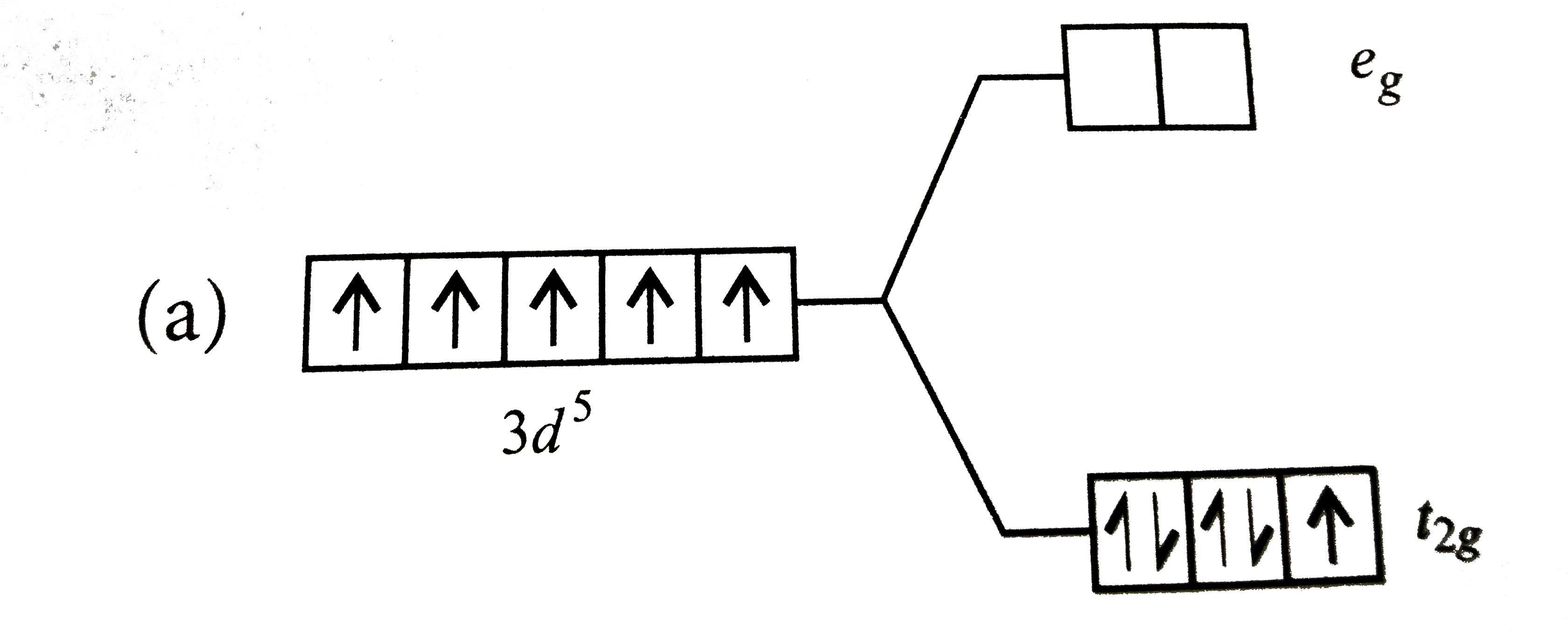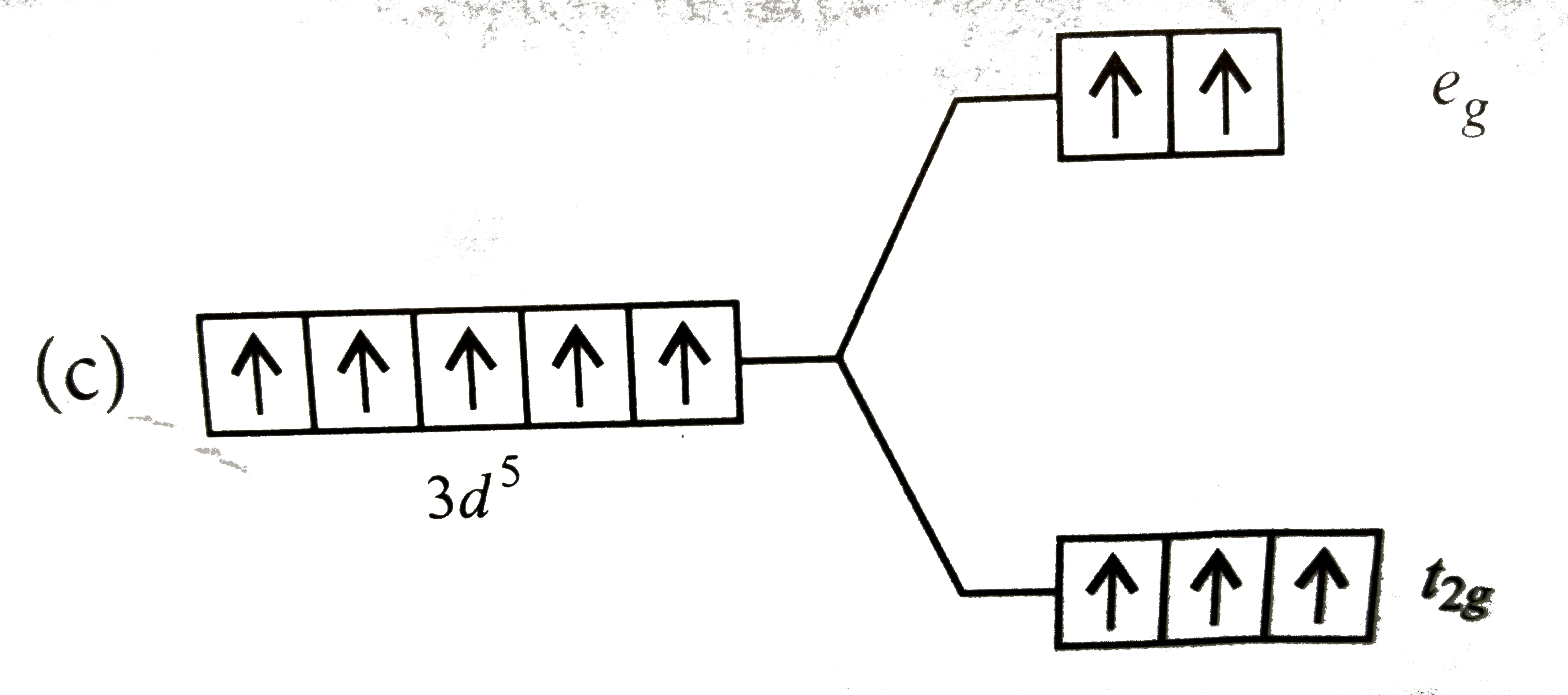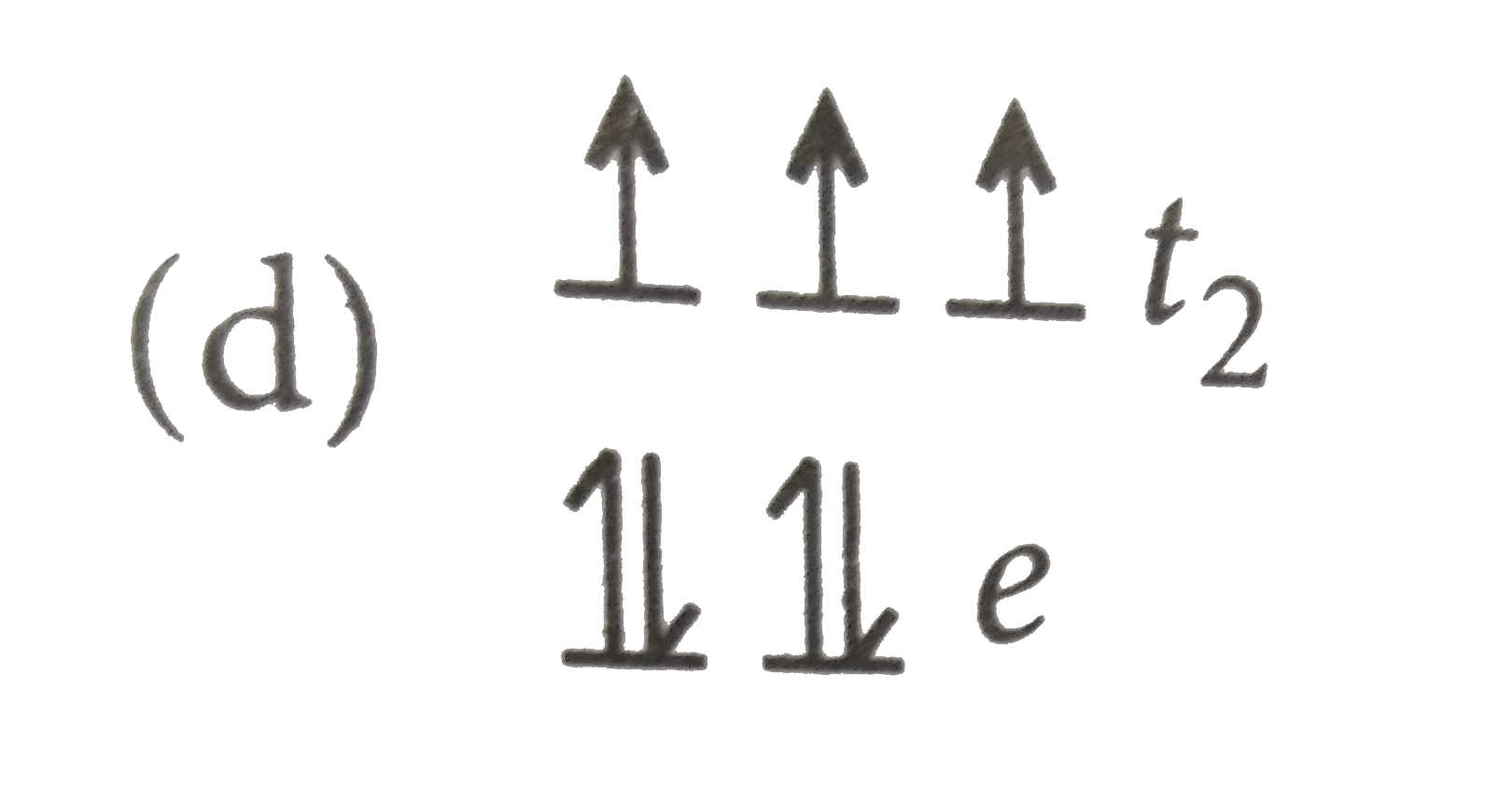Which of the following energy level diagram for [FeF6]3− is correct on the basis of crystal field theory ?




The correct Answer is:C
To determine the correct energy level diagram for the complex ion (FeF6)3− based on crystal field theory, we will follow these steps:
Step 1: Determine the oxidation state of Iron (Fe)
1. The complex ion is (FeF6)3−.
2. Each fluorine (F) has an oxidation state of -1.
3. Let the oxidation state of Fe be x.
4. The equation can be set up as follows:
x+6(−1)=−3
x−6=−3⟹x=+3
Therefore, the oxidation state of Fe in (FeF6)3− is +3.
Step 2: Write the electronic configuration of Fe
1. The atomic number of Fe is 26, and its ground state electronic configuration is:
(Ar)3d64s2
2. Since Fe is in the +3 oxidation state, it loses 3 electrons. The electrons are removed first from the 4s orbital and then from the 3d orbital:
(Ar)3d5
Step 3: Identify the geometry of the complex
1. (FeF6)3− is an octahedral complex because it has six ligands (F) surrounding the central metal ion (Fe).
Step 4: Determine the splitting of d-orbitals
1. In an octahedral field, the 3d orbitals split into two sets: t2g (lower energy) and eg (higher energy).
2. The energy level diagram for the d-orbitals in an octahedral field is as follows:
- t2g (three orbitals)
- eg (two orbitals)
Step 5: Consider the nature of the ligand
1. Fluoride (F) is a weak field ligand, which means it does not cause strong pairing of electrons.
2. Therefore, the electrons will occupy the available orbitals singly before pairing occurs.
Step 6: Fill the d-orbitals according to Hund's rule
1. Since we have 3d5 configuration and F is a weak field ligand:
- The first three electrons will fill the t2g orbitals singly.
- The next two electrons will fill the eg orbitals singly.
The filling will look like this:
- t2g: 3 electrons
- eg: 2 electrons
Step 7: Draw the energy level diagram
1. The correct energy level diagram will show:
- t2g with 3 electrons
- eg with 2 electrons
Conclusion
The correct energy level diagram for (FeF6)3− based on crystal field theory is that there are 3 electrons in the t2g level and 2 electrons in the eg level.
1. The complex ion is (FeF6)3−.
2. Each fluorine (F) has an oxidation state of -1.
3. Let the oxidation state of Fe be x.
4. The equation can be set up as follows:
x+6(−1)=−3
x−6=−3⟹x=+3
Therefore, the oxidation state of Fe in (FeF6)3− is +3.
1. The atomic number of Fe is 26, and its ground state electronic configuration is:
(Ar)3d64s2
2. Since Fe is in the +3 oxidation state, it loses 3 electrons. The electrons are removed first from the 4s orbital and then from the 3d orbital:
(Ar)3d5
1. (FeF6)3− is an octahedral complex because it has six ligands (F) surrounding the central metal ion (Fe).
1. In an octahedral field, the 3d orbitals split into two sets: t2g (lower energy) and eg (higher energy).
2. The energy level diagram for the d-orbitals in an octahedral field is as follows:
- t2g (three orbitals)
- eg (two orbitals)
1. Fluoride (F) is a weak field ligand, which means it does not cause strong pairing of electrons.
2. Therefore, the electrons will occupy the available orbitals singly before pairing occurs.
1. Since we have 3d5 configuration and F is a weak field ligand:
- The first three electrons will fill the t2g orbitals singly.
- The next two electrons will fill the eg orbitals singly.
The filling will look like this:
- t2g: 3 electrons
- eg: 2 electrons
1. The correct energy level diagram will show:
- t2g with 3 electrons
- eg with 2 electrons
The correct energy level diagram for (FeF6)3− based on crystal field theory is that there are 3 electrons in the t2g level and 2 electrons in the eg level.
Topper's Solved these Questions
- COORDINATION COMPOUNDS BOOK - NCERT FINGERTPS ENGLISHCHAPTER - COORDINATION COMPOUNDS EXERCISE - HOTS
8 Videos
- COORDINATION COMPOUNDS BOOK - NCERT FINGERTPS ENGLISHCHAPTER - COORDINATION COMPOUNDS EXERCISE - NCERT EXEMPLAR PROBLEMS
14 Videos
- CHEMISTRY IN EVERYDAY LIFE BOOK - NCERT FINGERTPS ENGLISHCHAPTER - CHEMISTRY IN EVERYDAY LIFE EXERCISE - NCERT Exemplar
15 Videos
- ELECTROCHEMISTRYBOOK - NCERT FINGERTPS ENGLISHCHAPTER - ELECTROCHEMISTRYEXERCISE - Assertion And Reason
15 Videos
Similar Questions
Consider the following energy level diagram:

Answer the following question on the basis of the given diagram
In the given diagram z refers to
View SolutionConsider the following energy level diagram:

Answer the following question on the basis of the given diagram
The heat of formation of glucose is
View Solution
Knowledge Check
Which of the following energy diagrams shows the electron distribution according to the crystal field model of the 3d-electrons in [CoCl4]2− ?
A B
B C
C D
D
Electronic configuration of [Cu(NH3)6]2+ on the basis of crystal field splitting theory is
At42ge5gBt62ge3gCt92ge0gDt52e4gWhich of the following postulates of kinetic theory of gases is not correct ?
AGases consist of particles which are in continuous , random motion .BThe particles are infinitely small and very close to each other.CThe collisions of the particles with each other are elastic .DThe pressure of a gas is caused by the collisions of gas particles with the wall of the container .
Consider the following energy level diagram:

Answer the following question on the basis of the given diagram
The quantity y is equal to
View SolutionExplain the violet colour of the complex [Ti(H2O)6]3+ on the basis of crystal field theory.
View SolutionChange with descent it the basis of which theory :
View Solution(i) What type of isomerism is shown by the complex [Cr(H2O)6]Cl3?
(ii) On the basis of crystal field theory, write the electronic configuration for d4 ion if Δ0>P.
(iii) Write the hybridization and shape of [CoF6]3−. (Atomic number of Co=27)
View SolutionWhich of the following statement(s) is /are correct with respect to the crystal field theory ?
View Solution
